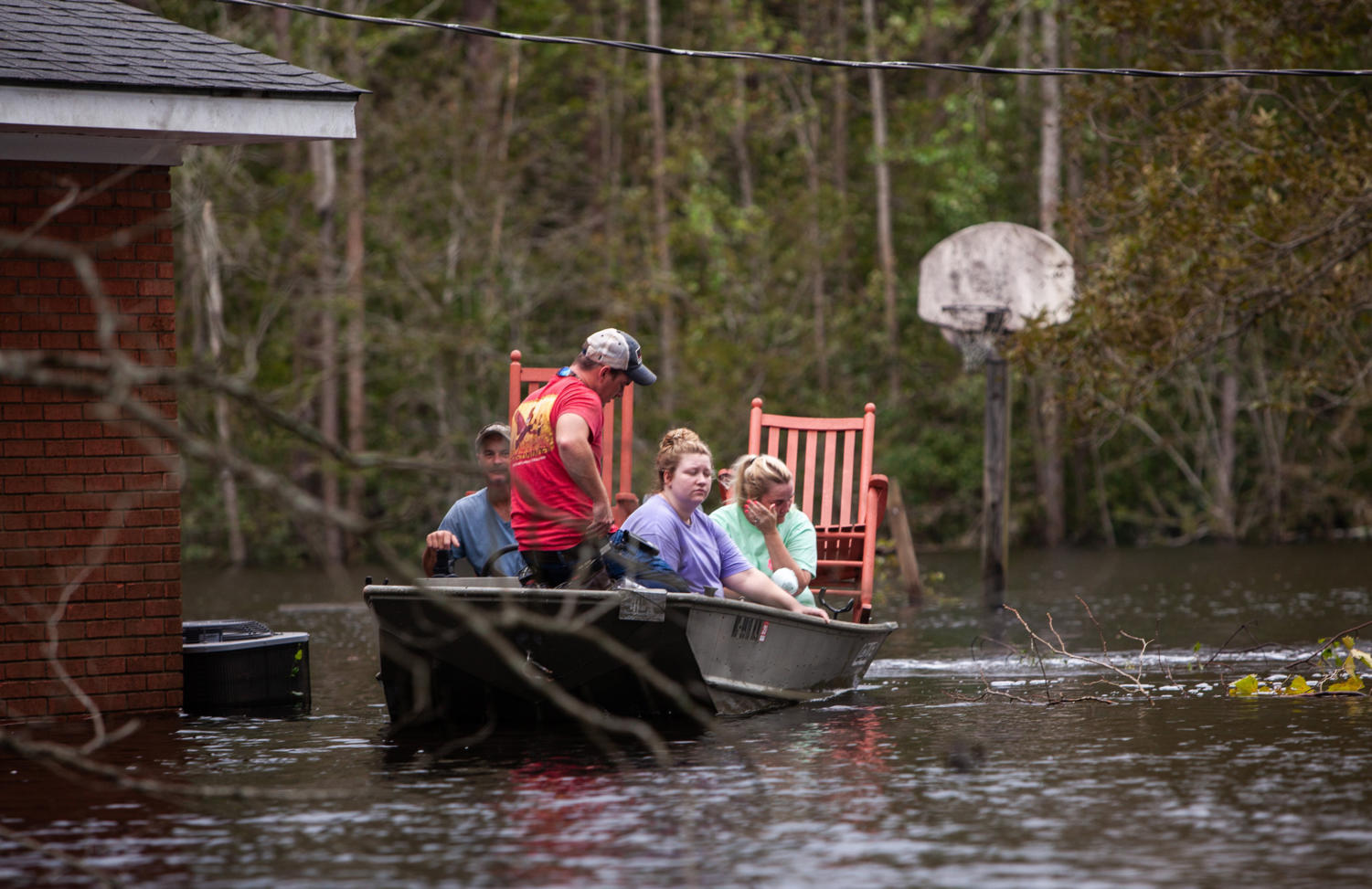Rising waters continue to frustrate rescue efforts and residents, FEMA chief says after NC tour


From left, Mike Haddock, 48, Justin Humphrey, 24, Katlyn Humphrey, 19, and Michelle Haddock, 45, remove possessions from the Haddocks' flooded home using a jon boat on Monday, Sept. 17, 2018 in Trenton, N.C. following Hurricane Florence. (Travis Long/Raleigh News & Observer/TNS)
Rivers continued to rise out of their banks across the Carolinas on Tuesday, frustrating rescue efforts and residents hoping to return home.
North Carolina Gov. Roy Cooper and Brock Long, administrator of the Federal Emergency Management Agency, acknowledged the difficulties following a tour of flooded areas in the Tar Heel State.
“It’s really important for me to get out of D.C. and make sure we’re doing a good job,” Long said, adding that he’s pleased with what he’s seen but “the next 48 hours are going to be incredibly critical.”
“We realize there’s a lot of displaced folks and we’re doing what we can to make life better,” Long said. “It’s going to take some time for these waters to recede.”
The FEMA chief said floodwaters have hampered repair crews trying to reopen roads and restore power.
He said officials would examine the impact of the storm on the environment and industry. Environmental groups worried the storm may have washed away toxic ash from power plants and hog waste from open-air storage lagoons. Up to half of the state’s tobacco crop was still in the fields and could be damaged, Cooper said, along with cotton and peanut crops.
“We’re going to be dealing with a lot of hazardous waste, agricultural issues,” he said.
Long said FEMA sent several thousand claims adjusters and disaster assistance teams to community centers and shelters in storm-battered areas to register people for assistance “so we can kick-start recovery.”
He said he has been discussing options for temporary, post-storm housing with Cooper, who acknowledged the state has struggled with affordable housing.
Cooper urged storm victims to register with FEMA by phone or online, to evacuate as directed and not drive around road barricades. He asked evacuees not to return to coastal Hanover, New Brunswick and Pender counties yet, even though many feel the storm has become “a nightmare that just won’t end.”
“Sunshine doesn’t necessarily mean safety. Rivers continue to rise and we will see more flooding,” Cooper said.
He said the state’s death toll from Florence increased to 26 Tuesday. More than 2,200 people and 578 animals had been rescued from floodwaters, Cooper said, and 10,000 remained in shelters. Officials opened four emergency kitchens serving free hot meals in Kinston, Lumberton, New Bern and Washington and planned to open four more this week.
More than 1,100 roads have been closed, including I-95 and 40, and 343,000 people were still without power, Cooper said. An emergency ferry had been created between Morehead City and Wilmington that was expected to start shipping much needed supplies Wednesday, according to James Trogdon, the state’s transportation secretary.
Cooper said he would take Long on a visit to Wilmington late Tuesday, and he also planned to meet with President Donald Trump when he visits the state this week.
Florence’s peak rainfall — 35.94 inches at Elizabethtown, N.C. — was the fourth-highest for a U.S. hurricane since 1950 and left rivers across the Carolinas swollen.
The storm has killed a total of 32 people, including a 1-year-old boy whose body was found Monday after he was swept away by floodwaters near Charlotte.
Across North Carolina, 16 rivers had reached major flood stage Tuesday morning, and several more were expected to crest soon, according to Mike Steele, a spokesman for the state emergency management agency. He said high-water rescues were ongoing in several areas.
“The good news is we are starting to see a lot of them peak, but it is going to cause a lot of complications as far as access to roadways for an extended period of time,” said Steele, who came from the Baton Rouge, La., area to help with the disaster.
“This is the same situation we faced in Louisiana and Texas during Hurricane Harvey,” he said. “By the time you put a report out, some of the conditions have changed.” That has led officials to direct residents to stay off the roads or to check state transportation websites for updates.
Matt Stewart, 37, and his family of four were stuck in Raleigh after trying unsuccessfully to return home to Wilmington, blocked by road closures that have cut off that coastal city of 120,000. The family planned to try a new route Tuesday, convoying with a friend in a truck. His father had taken the same route days before, but Stewart was worried about flooding since.
“There isn’t any rivers or any lakes or ponds along that route,” Stewart said before setting off, worried his house, which had minor damage, might be leaking. “It’s my home, some of that stuff is irreplaceable.”
Wilmington, where the storm made landfall, has seen a Dollar Store looted and gas and food shortages. About 62,000 people there were still without power.
Officials were preparing to distribute food at three centers around the city Tuesday, said Jessica Loper, a spokeswoman for surrounding New Hanover County.
“These supplies are much needed by folks who can’t get to a store or don’t have a store near them,” Loper said.
She said some gas stations also reopened Tuesday, and cars were on the roads, “But we’re still very much in recovery mode.”
“Neighbors are helping neighbors. This is a true community effort to recover from this storm and the damage it’s caused,” she said.
Officials expect to know in coming days when roads into the city will be cleared, she said.
“A lot of it’s going to have to do with the rivers that are cresting,” Loper said.
Recent Posts
SGB addresses concerns about ICE presence on campus, hears SJP lawsuit against administration, approves governing code bill
At its weekly meeting on Tuesday at Nordy’s Place, Student Government Board heard concerns about…
ACLU of Pennsylvania sues Pitt over SJP suspension
The ACLU of Pennsylvania filed a federal civil lawsuit against the University of Pittsburgh and…
Marquan Pope: The ultimate shark
One of the most remarkable things about sharks is that an injury doesn’t deter them.…
Who Asked? // Do we really get a summer vacation?
This installment of Who Asked? by staff writer Brynn Murawski mourns the seemingly impossible perfect…
Notes From an Average Girl // Notes from my junior year
In this edition of Notes From an Average Girl, senior staff writer Madeline Milchman reflects…
Meaning at the Movies // The Power of the Movie Theater
In this edition of “Meaning at the Movies,” staff writer Lauren Deaton discusses her love…

